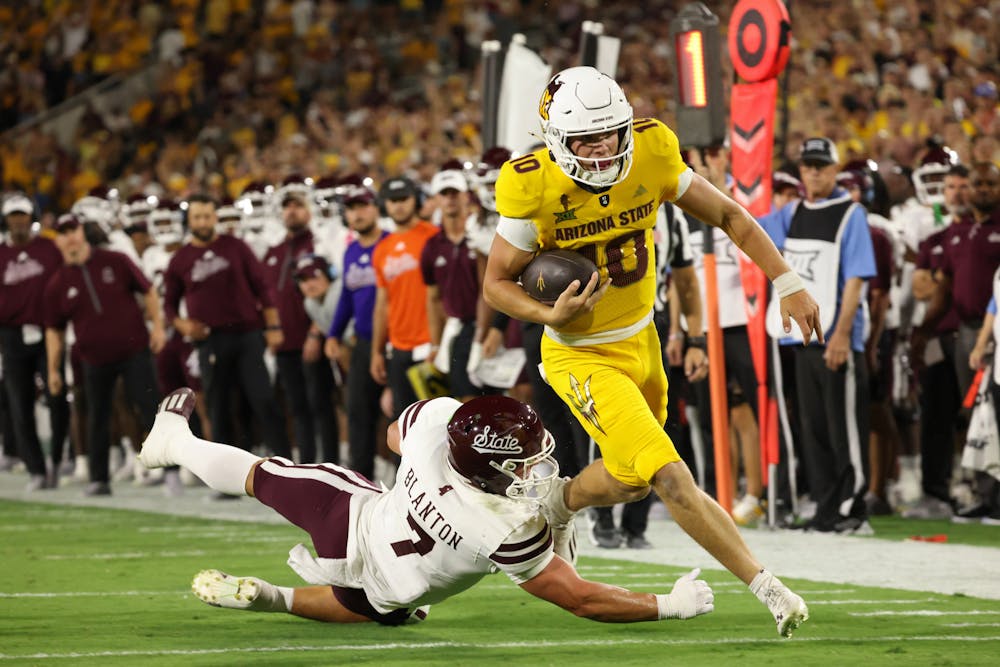For some, football is a game of confusing numbers that can look like the ones and zeros of computer code. Modern teams are using advanced metrics to gain an advantage while analysts are doing the same to better explain football.
The increased coverage of these advanced metrics can be traced back to football teams and programs themselves.
The reason for the surge of football analytics is simple: Certain advanced statistics can describe the outcomes and happenings of games in a way box scores often can't. Here is a glossary of advanced statistics all Sun Devil fans should know.
The Game Itself
Expected Points Added (EPA) — EPA measures efficiency in points instead of measuring efficiency based on yards. At a fundamental level, EPA is the difference in expected points before and after each play. The metric can be attributed to both players and teams.
Success Rate — The success of a play is contextualized based on down and distance. For example, a five-yard gain on first and 10 is successful, whereas a five-yard gain on third and 10 is a failure. The significance of this metric gives a sense of how consistently effective both offensive and defensive groups are throughout a game.
Win Probability Added (WPA) — This statistic measures how much each specific play alters a game's outcome, or win probability. This statistic can not only be attributed to particular plays, it can be attributed to a player's contribution throughout an entire game.
The Middle Eight — This term consists of the last four minutes of the first half and the first four minutes of the second half. Middle Eight statistics express traditional statistics, such as yards, plays, and points, in a particular situation in this specific period. Coaches often cite the Middle Eight as an important factor in games including ASU head coach Kenny Dillingham.
Offensive Stats
Explosive Plays — Any play that gains 10-plus yards on a run or 15-plus yards on a pass is considered an explosive play.
Offensive Line Yards — This estimates the number of rushing yards attributed to the offensive line, not the ball carrier. These yards typically occur at the first level of defense, before the ball carrier makes it to the second level.
Highlight Yards — Once the ball carrier makes it to the second level, the rest of the gained yardage is credited solely to them through highlight yards. The statistic measures how much of a run's yardage is determined by the runner.
Opportunity Runs — Runs that gain four or more yards are known as opportunity runs. These runs can be effective descriptors because they show a middle ground between ineffective runs and explosive runs. For example, an offense can have 200-plus rushing yards without many explosive runs because of opportunity runs.
Defensive Stats
Havoc Rate — This computation gives a sense of how much chaos a defense generally causes. It measures the percentage of plays in which a defense records a tackle for loss, forced fumble, interception or pass deflection. A high havoc rate may indicate defensive aggressiveness.
Stuffed Runs and Stopped Runs — Stuffed runs are runs where zero or fewer yards are gained. Stopped runs are runs where two or fewer yards are gained. The more stuffed runs and stopped runs a defense accumulates, the more effective that defense is in stopping the run.
Turnover Luck — This statistic takes turnover luck, typically a subjective and unmeasurable statistic, and expresses it numerically in points. Such numerical expression provides an objective look at how lucky or unlucky a team is in the turnover battle.
Stop Rate — This statistic is the percentage of defensive drives resulting in a punt or turnover. It describes the ability for a defense to stop an offense on a drive-to-drive basis.
Hopefully, with these terms, even a casual fan feels prepared to understand the complex statistics and inner workings of ASU football.
Edited by Jack Barron, Sophia Ramirez and Natalia Jarrett.
Reach the reporter at jwkartso@asu.edu and follow @kartsonis3 on X.
Like The State Press on Facebook and follow @statepress on X.
Jack is a sophomore studying sports journalism. This is his second semester with The State Press. He has also worked at other student journalism organizations.




